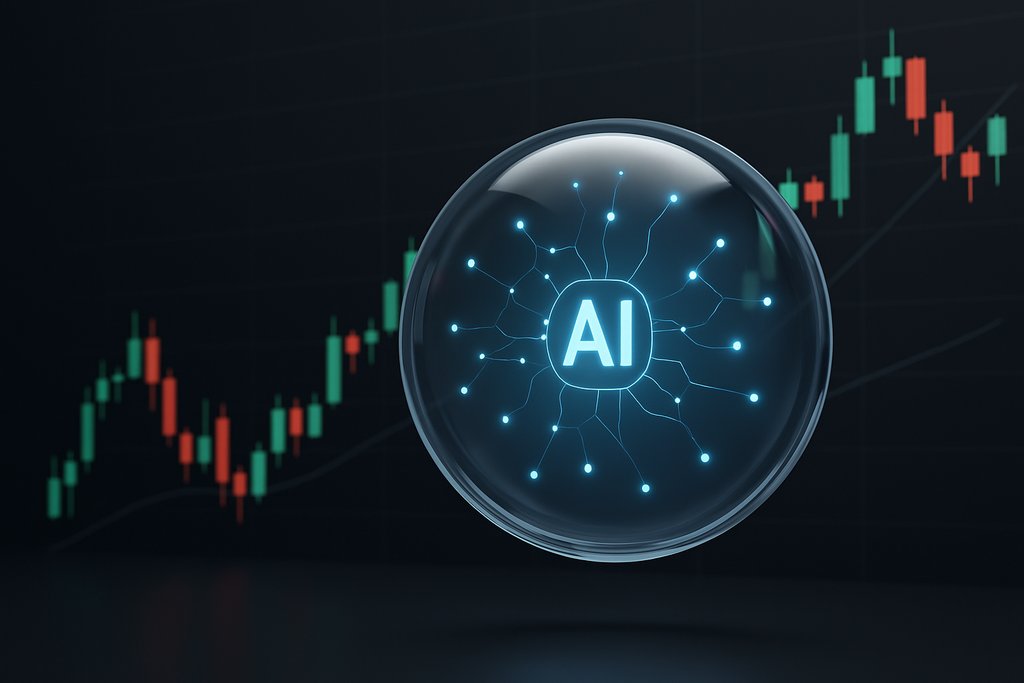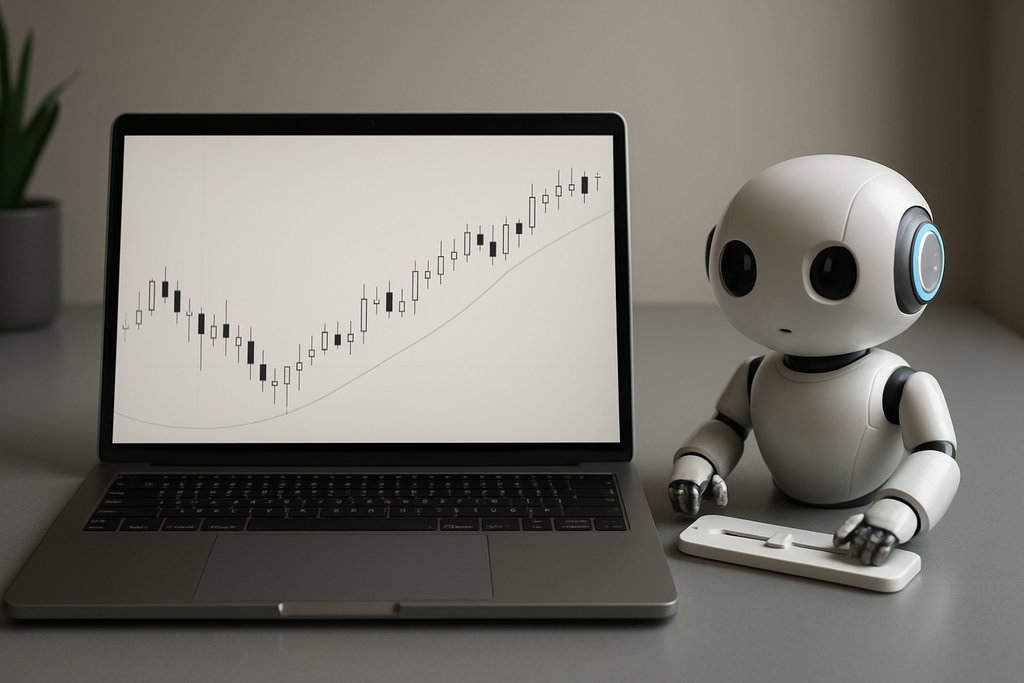Artificial Intelligence Trading Bot: How It Works Guide
Learn how an artificial intelligence trading bot turns data into signals and automated trades, plus practical steps to build or use one today.

Table of contents
- What is an artificial intelligence trading bot?
- How AI trading bots work
- Build or buy an AI trading bot
- Step-by-step: build in one afternoon
- Practical examples you can run today
- Benefits and considerations
- Key metrics and backtesting hygiene
- Getting started with Obside
- FAQ
Markets move faster than any human can scan a chart or read a news feed. If you searched for artificial intelligence trading bot, you are likely looking for more than hype. You want a clear definition, how these systems make decisions, what they need to succeed, and how to use one without getting lost in code. This guide delivers focused, practical knowledge for traders who want to move from curiosity to implementation.
What is an artificial intelligence trading bot?
An artificial intelligence trading bot is software that uses machine learning and related methods to analyze data, generate signals, and execute orders automatically. Unlike simple rule systems that follow fixed checklists, AI trading bots learn relationships from data. They can adapt to new information, weigh signals dynamically, and update parameters as market conditions shift.
At a high level, these systems ingest data, transform it into features, estimate the probability that a trade will be profitable, and then decide whether to buy, sell, or hold within a predefined risk framework. They can act across asset classes such as stocks, futures, forex, and crypto, and operate on timeframes from seconds to months.
If you want a formal grounding in related concepts, see algorithmic trading on Investopedia and artificial intelligence on Wikipedia. For a product-focused overview, explore our guide to algorithmic trading and how it connects to automated execution.
How AI trading bots work: data, models, signals, execution
Most effective AI trading bots share a similar architecture. Understanding each component helps you judge quality and avoid common pitfalls.

Data pipelines and feature engineering
Data is the fuel. Price and volume are essential, but many AI bots add technical indicators, market microstructure signals, options data, sentiment, and macro calendars. Natural language processing can turn news and social platforms into usable features by scoring tone, relevance, and novelty. Your pipeline should clean data, align timestamps, handle survivorship bias, and treat missing values consistently.
Well crafted features often include returns over multiple windows, volatility regimes, trend strength, momentum, mean reversion flags, order book imbalance, and indicator crossovers. Daily and intraday features can coexist if you aggregate consistently.
Alpha generation with machine learning
The model turns features into predictions. Common approaches include supervised learning to predict future returns or the probability of a positive move, sequence models when order matters, reinforcement learning for policy discovery, and NLP models to score news or filings. The output is typically a score or probability that is converted into a position size using thresholds or portfolio optimization.
Risk management and portfolio construction
Prediction quality matters, yet position sizing and risk controls often drive real-world results. Robust AI bots apply constraints like maximum exposure, per-trade stop losses, trailing stops, volatility targeting, and correlation limits. They also account for transaction costs, slippage, and capacity. Sizing can be as simple as allocating more to higher confidence signals or as advanced as mean-variance optimization with regularization to reduce turnover.
Execution and latency
Signals have half-lives. Fast strategies need low-latency execution and smart routing to reduce market impact. Even for swing trading, your execution layer should handle partial fills, rate limits, and retries, and fail safe if a broker API is down. Paper trading reduces deployment risk before real money goes live. Learn how to choose backtesting software that mirrors live conditions for better execution confidence.
Monitoring and continuous learning
Markets change. Good bots monitor production performance, detect regime shifts, and retrain on rolling windows. Walk-forward validation and nested cross-validation limit overfitting. Alerting on drawdowns, slippage spikes, or feature drift keeps you proactive instead of reactive.
Build or buy an artificial intelligence trading bot
You have two main paths. Build your own stack in Python and integrate with broker APIs, or use a platform that compresses setup and maintenance into a service. Coding from scratch gives maximum control, but you must own ingestion, modeling, backtesting, order management, paper trading, live execution, and monitoring.
Platforms can streamline the journey. Obside is a financial automation SaaS that turns plain-language ideas into market actions in seconds. Chat with Obside Copilot, describe what you want, and Obside creates alerts, automations, or full strategies and executes them with your connected brokers and exchanges. It supports prices, indicators, news, and macro data in real time, with ultra-fast backtesting to validate quickly. See also our overview of AI trading bots for a deeper dive into build steps and trade-offs.

Step-by-step: from idea to an AI-driven bot in one afternoon
A disciplined workflow keeps your build focused and reduces the temptation to overfit. Each step can be executed with custom code or accelerated using a platform like Obside.
1) Define the objective
Clarify market, timeframe, risk tolerance, and evaluation metric. Example: trade large-cap equities on the 30-minute timeframe, target a Sharpe ratio above 1 with max drawdown under 15 percent.
2) Gather and clean data
Include price, volume, and indicators. Add news or social data if you intend to use NLP-based features. Align timestamps and check for look-ahead bias.
3) Create features
Match features to your hypothesis. For momentum, use rolling returns, trend filters, and RSI thresholds. For event-driven ideas, measure sentiment change and headline novelty.
4) Choose a model
Start simple. Gradient boosting often provides a strong baseline and is easier to debug than a deep network.
5) Backtest with care
Use walk-forward validation and out-of-sample testing with realistic costs and slippage. Track Sharpe, Sortino, max drawdown, Calmar, hit rate, and profit factor. For definitions, see the Sharpe ratio on Investopedia. Consider practicing with a trading automation sandbox that matches live execution constraints.
6) Stress test
Change parameters, delay entries, inject noise, and rerun on different regimes. A robust strategy should not collapse when assumptions are nudged.
7) Deploy with safeguards
Start with paper trading, set conservative limits, implement hard stops and daily loss limits, then scale slowly.
8) Monitor and iterate
Set alerts for slippage spikes, performance degradation, or feature drift. Treat your model like a living system that needs care.
Try these in Obside Copilot to go from idea to execution quickly.
Alert me if Bitcoin rises above $150,000 and daily volume doubles
Notify me if RSI crosses 70 on EUR/USD and MACD turns bearish
Buy $1,000 of Bitcoin if the price is below $100,000
Sell all my positions if the S&P 500 drops by 10%Practical examples of AI trading bots you can run today
The best way to learn is to translate ideas into concrete automations. Below are practical scenarios that blend AI-style thinking with clear rules. Use them as templates and refine with your own filters and risk controls.
News and event-driven trading. Use NLP to detect sentiment and relevance, then act only when the signal is strong. For example: alert me if Apple announces a new product, or sell my positions if an official source announces new tariffs. Tighten with concurrent price or volume conditions such as alert me if Bitcoin rises above 150,000 dollars and daily volume doubles.
Social sentiment triggers. Short bursts of attention can move prices. An automation like buy 50 dollars of Tesla if Elon Musk tweets about it ties a social feed trigger to an action. Add a stop and a time-based exit to avoid overstaying.
Technical momentum with AI filters. Start with classic conditions like notify me if RSI crosses 70 on EUR/USD and MACD turns bearish, then add a model filter that only triggers when volatility is in a certain regime or when your score exceeds a threshold.
Portfolio rules and risk parity. Allocation can be automated too. A rule like keep 50 percent in Bitcoin, 25 percent in Ethereum, and 25 percent in USDC can be enhanced by an AI overlay that scales down exposure when forecasted volatility rises.
DCA with smarter entries. A simple schedule like buy 50 dollars of Bitcoin every Monday at 10:00 AM can skip buys when the short-term outlook is weak and double size when odds improve.
Benefits and considerations of AI trading bots
AI can amplify an edge, but only if you respect both power and risk. Focus on validation and risk controls to turn promising ideas into durable strategies.
- Speed across many markets
- Scalability and 24/7 operation
- Consistent, rules-based discipline
- Multi-source signal fusion
Important considerations include data quality, overfitting, slippage and costs, execution quality, transparency, and compute or data expenses. A model can fit noise and look brilliant in backtests yet fail in production.
Key metrics and backtesting hygiene for AI trading bots
Evaluate more than a single headline metric. Study the shape of returns, stability over time, and sensitivity to assumptions. Track risk-adjusted measures like Sharpe and Sortino, max drawdown, profit factor, hit rate paired with average win or loss, and turnover or capacity limits.
Treat backtests as experiments. Use walk-forward validation by training on rolling windows and testing out of sample. Add realistic costs and slippage. Delay entries by one bar to avoid look-ahead bias, and randomize small amounts of noise to inputs to test robustness. Then run a paper trading phase to compare live-like execution results to your backtest. For practical tooling, see our guide to backtesting software.
Getting started with Obside and AI trading bots
If you want to move from idea to execution quickly, open an account on Obside and try a few prompts. Start with alerts to learn the interface, then progress to actions and full strategies. When satisfied with backtests, connect your broker and go live. For a broader overview of AI-driven automation, read AI trading and how it maps signals to execution.
Obside’s ultra-fast backtester lets you validate logic in seconds, then run it live with your connected brokers and exchanges. The platform is recognized by professionals and was awarded the Innovation Prize 2024 at the Paris Trading Expo.
FAQ
Are artificial intelligence trading bots profitable?
They can be, but profitability depends on data quality, model robustness, risk controls, execution, and costs. Strong backtests do not guarantee live results. Validate with walk-forward testing, paper trade, and scale gradually while tracking slippage and drawdowns.
Do I need to code to use an AI trading bot?
Not necessarily. Platforms like Obside let you describe strategies in plain language and automate them without writing code. If you prefer custom models, coding helps, but you can still leverage a platform for execution, alerts, and risk controls.
Which markets can AI trading bots trade?
Most bots can operate across equities, ETFs, futures, forex, and crypto, provided you have reliable data and broker connections. Obside connects to brokers and exchanges so you can run rules on multiple markets from one interface.
How do I avoid overfitting my AI model?
Keep models as simple as possible at first, use out-of-sample testing and walk-forward validation, include realistic costs, and stress test with parameter and data perturbations. Favor stable, repeatable edges over one-time artifacts in historical data.
Disclaimer: This article is for educational purposes only. It is not financial advice. Trading and investing carry risks, including the loss of capital. Always do your own research and consider your risk tolerance before deploying any strategy.
Prefer to explore first and see how chat-driven automation works across markets and data sources.
